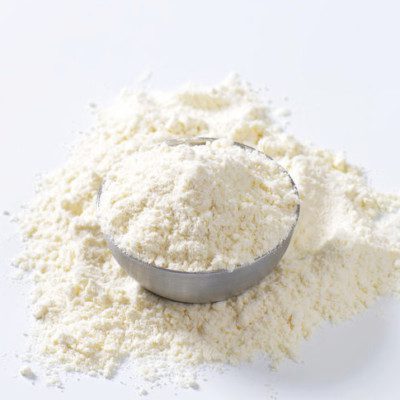
面粉质量
什么是面粉质量?
Flour quality encompasses all measurable or quantifiable parameters that are related to wheat or any cereal flour used to produce baked goods, snacks and many other products. In the baking industry, flour qualityis evaluated on a daily basis, both at laboratory and production line level.
用于确定面粉质量的参数包括:1
- 理化特征:蛋白质含量,湿面筋含量,灰分含量作为提取率的指标,水分水平,酶活性,粒度分布
- Empirical rheological properties: mixing stability, resistance to deformation forces, elasticity, extensibility, optimum water absorption
- Microbiological indicators
- Presence/absence of chemical hazards, such as heavy metals or mycotoxins
How it works
小麦粉与水混合时可以形成粘弹性和粘性质量的能力独特,并在防止面团和烘烤过程中握住酵母产生的气体。这归因于蛋白质含量,甚至更重要的是,特定的蛋白质成分是组合麸质storage proteins gliadin and glutenin.
与面包制作相关的小麦的面粉质量通常由四个主要因素决定:2,3
- 蛋白质含量(定量因素):小麦仁的蛋白质数量主要取决于品种,土壤类型,补充土壤养分和作物生长条件(例如气候条件)。
- 成分形成麸质蛋白(麸质蛋白与基质蛋白的比例):保湿后,麦醇溶蛋白作为一种非常可扩展的材料,几乎是一种粘性液体,而谷替蛋白则是粘性固体。尽管两者都会影响麸质行为,但较大的聚合物麸质对麸质质量产生了更大的影响。
- 麸质的分子尺寸分布:高分子体重(HMW)谷氨酸亚基在面团流变和麸质强度中具有重要作用。
- 含有硫醇基团的麸质蛋白的半胱氨酸残基的数量和位置(即氧化潜力)。
关于上面列出的前三个因素,在面包店层面几乎没有完成,因为它们主要取决于自然和谷物遗传学。但是,面包师确实有机会改变面粉的氧化潜力。当使用具有较弱的麸质蛋白质的低质量面粉时,这至关重要。
Bread’s porous and aerated structure is mainly due to the gluten in wheat. Gluten gives dough its unique viscoelastic nature that is able to retain gases and allow pizza dough to be stretched. It is important to recognize that the structure of gluten is held together by sulfur-to-sulfur bonds (S-S) created by cysteine residues. Without enough sulfur and disulfide bonds, bread has a very low gas retention capacity, resulting in something more like a brick than a light finished product.
Application
Flour quality in the baking industry is often related to the breadmaking performance or baking potential of wheat flour. In such cases, flour quality is expressed in terms of product volume and crumb grain structure. ‘High quality’ flours intended for bread production often yield the highest specific volumes with standard formulations.
What defines flour quality for a baker is highly variable and subjective, and related to the desired end product. What can be universally said about flour quality is that it needs to be consistent throughout time.
从面包师的角度来看,他们的第一个愿望是他们购买的面粉在生产线上表现出一致且可预测的烘焙性能。性能差异很高的面粉会导致产品质量以及时间,金钱和废物花费的变化。
可以通过使用来修改和改进打算用于面包生产的面粉的质量面团护发素andenzymes. Amylases and oxidizing agents are the most frequently used flour improvers used nowadays.3
硬麦的常见面粉成分
| 成分 | Percent flour weight (%) |
| 水分 | 13.0 - 14.0 |
| 完整的淀粉 | 63.0 - 72.0 |
| Damaged starch | 5.0 - 9.0* |
| 蛋白质(总) | 11.0 - 14.5 |
| Water-soluble proteins (albumins and globulins) | 20.0(总蛋白质) |
| Gluten-forming proteins (insoluble fraction comprised of gliadins and glutenins) | 80.0 (of total protein) |
| 非淀粉多糖(NSP) | 3.0 – 4.0 |
| 五角星 /半纤维素(阿拉伯木基) | 65.0 - 70.0(总NSP) |
| β-葡聚糖 | 33.0 (of total NSPs) |
| 纤维素 | 非常低(在麸皮中发现) |
| 脂质 | 1.0 – 2.5 |
| 极性(糖脂和磷脂) | 55.0 (of total lipids) |
| 非极性(甘油三酸酯,FFA,单甘油和二甘油三酸酯) | 45.0 (of total lipids) |
*实际量取决于内核硬度,谷物回火和铣削条件以及提取率
面包粉的技术规格
典型的面包粉物理化学属性来自74%的萃取硬麦:
| 成分 | Value |
| 水分 | 13.5% |
| 蛋白质含量(N x 5.7) | 12.5% |
| Ash | 0.45 - 0.55% |
| 湿面筋 | 27.0 - 32.0% |
| 干麸质 | 10.0 – 12.0% |
| Falling Number | 350 – 450 |
| Particle size index, PSI | 13.0 – 16.0% |
| pH | 5.8 – 6.2 |
参考
- Finnie, S., and Atwell, W.A. Wheat Flour Handbook Series, 2nd edition, AACC International, Inc., 2016.
- Carson,G.R。和N.M. Edwards“小麦和面粉质量的标准”。小麦化学技术,第四版,AACC International,Inc.,2017年,第97-123页。
- Putseys,J.A.,Schooneveld-Bergmans,M.E.F。“用于烘烤的酶。”工业酶应用,Wiley-VCH Verlag GmbH&Co。KGAA,2019年,第97-118页。

Leave A Comment